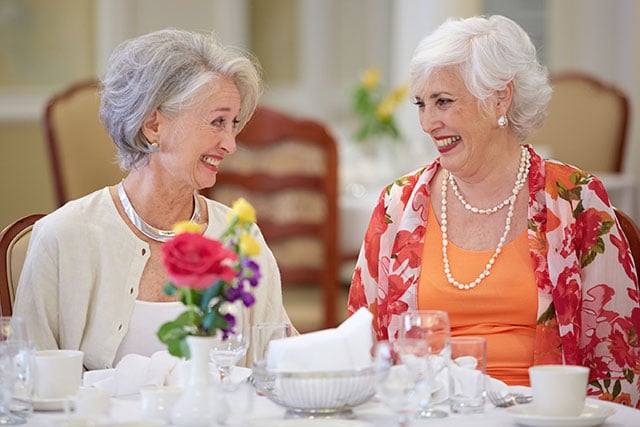
Have you ever been to a popular restaurant that’s so busy they have a big table that can accommodate multiple parties at the same time? Shared tables enable the restaurant to serve more patrons faster, but diners benefit as well. You get to meet and share a meal with strangers who morph into acquaintances and perhaps even future friends.
Mark Holmes, the national director of culinary operations at The Goodman Group, was inspired by this dining model and subsequently developed it into what The Goodman Group now calls the “fellowship table.”
Mark has been able to implement this dining style in many managed senior living communities over the years and has seen first-hand how easy and effective it can be. “It costs nothing to operate,” he points out, yet the benefits can be extensive.
Why Fellowship Tables
It can take some time for a person to adjust to life in a senior living community both from a social and nutritional perspective. It is not uncommon for new residents to feel withdrawn as they navigate their new life. Similar to a child attending a new school, it can be daunting to find someone to sit and eat with for the first few days. Seniors also deal with this, sometimes leading to them skipping meals entirely.
Ensuring adequate nutrition and calorie consumption is essential for the ongoing health and well-being of older adults. Furthermore, regular meals in the dining room foster social interaction among residents, which greatly contributes to emotional well-being.
Fellowship tables promote social interactions as well as a consistent eating schedule. By removing the barrier of where to sit, new residents can more easily get into the dining room rhythm and immediately start to connect with new friends. Feeling comfortable in their new environment will help seniors from feeling recluse, mitigating the chance of skipping meals.
Always Open to All
At senior living communities managed by The Goodman Group, resident ambassadors always go visit new residents to say hello, take them to dinner and introduce them to the community. After that, the new resident is welcome to engage with the community as they please, which more often than not, leads them to the fellowship table.
Fellowship tables that seat 10 or 12 make it easy to meet other people, socialize and gradually make friends to sit with at smaller tables. It can be a defining step in acclimating to the dining room experience whether you’re an introvert or a natural extrovert.
Want to make as many friends as possible quickly? Sit at the fellowship table. Feeling reticent at first, especially since you don’t know the “rules” of the dining room? The fellowship table will help you blossom.
In some communities, residents have proactively pushed tables together to create their own communal dining opportunities. Their groupings may seat just six or eight, but the concept–and the benefits–are the same. It’s a destination, regardless of the number of seats.
Mark and his team members have seen many long-term friendships develop through this dining arrangement. “We’ve actually had couples get married as a result of meeting at the fellowship table,” he shares.
The fellowship table serves as a sort of fluid support group. Some residents choose to sit there every day, which is always welcomed, while others come and go as they please. Whether you are a new or long-time resident, there is always a spot for you at the fellowship table.


